 First, click I want to wish everyone a wonderful 2015.
First, click I want to wish everyone a wonderful 2015.
As many of you know, K2 was a tough climb for me causing me to go to places I never knew existed within myself. Now that I have taken time to reflect on that experience, I want to build upon what I learned.
The fight to find a cure for Alzheimer’s needs our unified support, caregivers need more help than ever and for me, I want to feed my passion for climbing.
I am driven by the intersection of purpose and passion thus with great excitement I want to share the details of Project 8000 for Alzheimer’s where over the next 5 years I will attempt the 11 remaining mountains above 8000 meters that I haven’t summited.
Background
I saw first hand what Alzheimer’s does to individuals and families when I lost my mom, Ida, and two aunts (my mom’s sisters) to Alzheimer’s Disease (AD) in 2009. The more I learned about AD, the more helpless I felt. Now six years later there is still no reliable means of diagnoses, no way of stopping it once a person has it and Alzheimer’s is 100% fatal – this is totally unacceptable in 2015.

That experience moved to to redefine my life’s purpose to become an Alzheimer’s Advocate using my passion of mountain climbing as the method to reach people.
My Memories are Everything ™ climbs have reached 50 million people with a message of hope, need and urgency around AD. Through your generosity, we have raised over $250,000 that went 100% to Alzheimer’s non-profits, including the Cure Alzheimer’s Fund who uses the funds exclusively for research. Other non profits that have benefited included the Alzheimer’s Association, UsAgainstAlzheimer’s and the Caregivers Action Network.
Thanks to these organizations and others, progress has been made in understanding Alzheimer’s yet due to lack of money, not ideas, a cure remains elusive. Meanwhile every 4 seconds, another family in the world begins the same fatal journey my family did with my mom.
It is with this urgency, I remain committed to making a difference. While climbing is an unusual method to raise awareness for Alzheimer’s, I have been able to reach an audience not usually touched by many Alzheimer’s non-profits. These include youth and young adults who are usually forgotten as caregivers. My partners have asked me to continue my efforts as it compliments their own.
Project 8000 for Alzheimer’s
There are 14 mountains above 8000 meters or 26,246 feet. 34 people have summited all 14, including only one American, Ed Viesturs. I will attempt to summit them from 2015 to 2020.
With my summits of Everest, K2 and Manaslu and good efforts on Shishapangma, Broad Peak and Cho Oyu, I feel well prepared to attempt these 11 mountains and optimistic we can reach the $1M goal for Alzheimer’s research.

My objectives for each climb include: safety, cause results, and climb success. To minimize costs, I will try to organize the climbs leveraging logistics from local organizations. Each climb will be conducted in small, safe teams utilizing proven Sherpa support, hopefully including Kami Sherpa whom I summited both Everest and K2 with in 2011 and 2014. I will utilize the services of Garrett Madison for some of the climbs.
As the 18th and oldest American to summit K2, I attracted world-wide attention, reached 5 million people and raised $70K in just 6 weeks. The Cure Alzheimer’s Fund said this was one of “most successful campaign ever” of its type. This combined with my 7 Summits campaign in 2011 that reached 30 million people, validated my model of using climbing to raise awareness and critically needed funds.
I want to again thank Janssen Alzheimer Immunotherapy and Abila for their support on those campaigns.
Sponsor Opportunities

I am ing sponsors for Project 8000. The expenses are modest when spread over five years, but the public relations need is large.
Ideally, one company will see the opportunity and support the entire project but individual climbs are still available to reduce the size of the investment. With the proper PR backing, I believe we can conservatively reach 100 million people. Using my website and social media, I can document a strong connection with my followers resulting in over 2.5 million annual interactions.
I am confident we can raise significant money from each climb reaching a total of $1 million from my Memories are Everything™ climbs. Please contact me for overall budgets and marketing opportunities.
Schedule
I would attempt approximately two climbs each year. My first climb is already scheduled for April/May 2015 of Lhotse, the world’s 4th highest. More on this soon but please note I will be doing my Everest season coverage as usual but this time from Everest Base Camp. Lhotse and Everest share 90% of the same route.
This is the proposed schedule, and I’m positive it will change.

Next Steps
I believe I can be used as living proof that if we live an active life, fully engaged, we can do amazing activities as we age. Please remember I am living with the fact that my mom and two aunts have died from Alzheimer’s and I may very well have the gene.
I hope you are as excited about Project 8000 as I am. I strongly believe we will raise awareness for Alzheimer’s but more importantly fund the search for a cure.
Climb On!
Alan
Memories are Everything
The 8000 meter Mountains
1-Everest
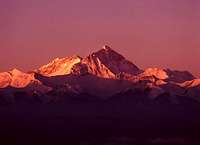 Other names: Sagamartha, Chomolangma or Qomolangma
Other names: Sagamartha, Chomolangma or Qomolangma
Altitude: 8848 m, 29,028 feet
Location: Tibet / Nepal
First ascent: May 29, 1953 by Sir Edmund Hillary and Tenzing Norgay with a British expedition
Summits/Deaths: 7,000/276 or 4.14%
Challenge : The two normal routes are mostly non-technical climbs but it is the altitude that makes Everest difficult. The south has the Khumbu Icefall that has claimed many lives and on the summit push, the Hillary Step, a short section of rock, challenges some people. The North side is windy and cold with a lot of exposed rock. On both routes fixed ropes are used from Base
Camp to the summit. Nowadays crowding is mentioned as a factor.
My Experience: I summited Everest on May 21, 2011. I climbed fast with IMG’s Kami Sherpa, making the climb from the South Col to the summit in 7:40 and returned in 3:20. This was my 4th attempt with non-summits in 2002, 2003 and 2008. read more
2-K2
 Other names: Mount Godwin-Austen or Chogori or Dapsang
Other names: Mount Godwin-Austen or Chogori or Dapsang
Altitude: 8611 m, 28,251 feet
Location: China / Pakistan
First ascent: July 31, 1954 by Achille Compagnoni and Lino Lacedelli, Italian
Summits/Deaths: 354/82 or 23.16%
Challenge: Arguably the world’s most difficult mountain to climb. It’s high, steep, with a high risk for avalanches and rock fall. The weather is often bad and there are no easy route to the peak’s summit. It is technical climbing from start to end. The North Ridge is a bit easier but the approach through China is demanding and long.
My Experience: I summited K2 on July 27, 2014. I climbed with Garrett Madison of Madison Mountaineering and Kami Sherpa once again.. It was an incredible climbed that started steep and never let up. The most fun was technical rock climbing on the Black Pyramid at 23,000′.
3-Kangchenjunga
 Other names: Kanchanfanga
Other names: Kanchanfanga
Altitude: 8586 m, 28,169 feet
Location: India / Nepal
First ascent: May 25, 1955 by George Band and Joe Brown
Expedition: Great Britain
Summits/Deaths: 284/43 or 15.14%
Challenge: It’s one of the largest of the peaks of the 8000ers and the route to the summit is long. This fact and the many short, but technical sections place Kangchenjunga firmly in the higher end of the difficulty list. The altitude is also a factor.
4-Lhotse
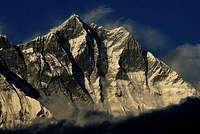 Altitude: 8516 m, 27.940 feet
Altitude: 8516 m, 27.940 feet
Location: Tibet / Nepal
First ascent: May 18, 1956 by Ernst Reiss and Fritz Luchsinger
Expedition: Switzerland
Summits/Deaths: 525/14 or 2.67%
Challenge: The normal route share the South Col route on Everest and starts with the Khumbu Icefall. The altitude and exposure on the final climb to the summit are contributing to the peak’s reputation of being one in the middle of the list in terms of difficulty.
5-Makalu
 Other names: Makalufeng
Other names: Makalufeng
Altitude: 8463 m, 27,838 feet
Location: Tibet / Nepal
First ascent: May 15, 1955 by Lionel Terray and Jean Couzy
Expedition: French
Summits/Deaths: 377/39 or 10.34%
Challenge: One of the more technical peaks and is amongst those considered hard climbs. Steep passages, both on rock and snow, exposure and avalanche danger makes this peak a tough target.
6-Cho Oyu

Location: Tibet / Nepal
First ascent: October 19, 1954 by Joseph Joechler, Pasang, Dawa Lama and Herbert Tichy
Expedition: Austrian
Summits/Deaths: 3,171/49 or 1.55%
Challenge: Technically speaking the easiest of the 14. No technical climbing, but large snowfields and long distances. Many climbers don’t reach the true summit, as it’s located some distance from where you enter the summit plateau and is only marginally higher than the fore summit.
My Experience: My first 8,000m peak. I climbed it from Tibet with IMG. A 5 week expedition, I reached 26,600′ (8,060m) on the summit plateau before turning back. It was a learning experience that I never forgot.
7-Dhaulagiri
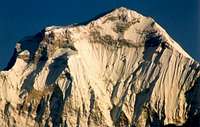 Other names: Aulagiri
Other names: Aulagiri
Altitude: 8167 m, 26,795 feet
Location: Nepal
First ascent: May 19, 1960 by Kurt Diemberger, Peter Diener, Nawang Dorje, Nima Dorje, Ernst Forrer and Albin Schelbert
Expedition:Switzerland
Summits/Deaths: 448/69 or 15.40%
Challenge: Considered to be a hard peak to climb by the pioneers in the area, but it’s nowadays considered as one on the lower half of the list. The normal route on the peak has some short technical sections and some avalanche danger, but overall it’s a quite straight forward climb.
8-Manaslu
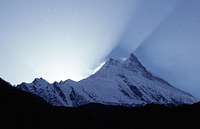 Other names: Kutang
Other names: Kutang
Altitude: 8163 m, 26,781 feet
Location: Nepal
First ascent: May 9, 1956 by Toshio Imanishi and Gyalzen Norbu
Expedition: Japanese
Summits/Deaths: 672/67 or 9.97%
Challenge: On the lower half of the peak’s normal route, avalanche danger is usually a main problem. Higher on the peak, the climb is mostly non-technical and easy. Manaslu has one of the higher death rates and is considered a dangerous peak.
My Experience: I summited Manaslu on September 25, 2013. The route was the most difficult in years due to a large avalanche in 2012 plus other mountain movements and a low snow year. The tiny summit was scary indeed!
9-Nanga Parbat
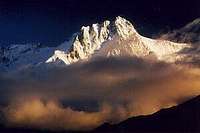 Other names: Diamir
Other names: Diamir
Altitude: 8126 m, 26,660 feet
Location: Pakistan
First ascent: July 3, 1953 by Hermann Buhl
Expedition: Austrian
Summits/Deaths: 335/68 or 20.30%
Challenge: Nanga Parbat’s normal route is not extremely technical, but it’s long and exposed. The mountain is infamous for bad weather and the route offers many tricky sections. It’s considered as one of the harder peaks.
10-Annapurna
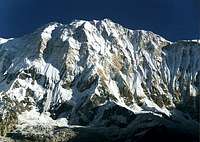 Other names: Morshiadi
Other names: Morshiadi
Altitude: 8091 m, 26,545 feet
Location: Nepal
First ascent: June 3, 1950 by Maurice Herzog and Louis Lachenal
Expedition: French
Summits/Deaths: 191/67 or 35.08%
Challenge: Considered the most dangerous of the 14. The north and its original route is not that technical, but extremely avalanche prone. The south is of high technical Challenge and also holds lots of objective danger.
11-Gasherbrum I
 Other names: Hidden Peak or K5
Other names: Hidden Peak or K5
Altitude: 8068 m, 26,444 feet
Location: China / Pakistan
First ascent: July 5, 1958 by Andrew Kauffman and Peter Schoening
Expedition: U.S.
Summits/Deaths: 334/29 or 8.68%
Challenge: When the icefall and some easy ground have been covered, the climb gets more difficult. Steep mixed climbing and some objective danger makes Gasherbrum I a peak which belongs with the more difficult 8000ers.
12-Broad Peak
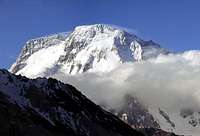 Other names: Falchen Kangri or K3
Other names: Falchen Kangri or K3
Altitude: 8047 m, 26,414 feet
Location: China / Pakistan
First ascent: June 9, 1957 by Hermann Buhl, Kurt Diemberger, Marcus Schmuck and Fritz wintersteller
Expedition: Austrian
Summits/Deaths: 404/21 or 5.20%
Challenge: Considered a straight forward climb. The constant, but quite low angled steepness to the summit ridge can hold avalanche danger, but apart from that no technical surprises. Some rocky sections around the false summits and exposure offers the final test before reaching the true summit.
My Experience: I organized this expedition to climb Broad Peak and then to “have a good showing” on K2. I reached 21,000′ on Broad or Camp 2 before abandoning the climb due to weakness that resulted from a severe bug I contracted on the trek in. The Karakorum ranges was magnificent and I was very lucky to have unbelievable weather for the month I spent there. It was instrumental having this experience for my summit of K2 in 2014.
13-Gasherbrum II
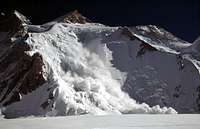 Other names: K4
Other names: K4
Altitude: 8035 m, 26,358 feet
Location: China / Pakistan
First ascent: July 9, 1956 by Josef Larch, Fritz Moravec, Hans Willenpart
Expedition: Austrian
Summits/Deaths: 930/21 or 2.26%
Challenge: Some years back G II was mentioned as one of the easiest 8000m peaks, usually together with Shishapamgma and Cho Oyu. After the “Banana Ridge’s” collapse the climb has become more difficult. The main obstacles are the huge icefall, crevasses, some steep climbing on snow and the exposure on the final part.
14-Shishapangma
 Other names: Gosainthan or Xixabangma
Other names: Gosainthan or Xixabangma
Altitude: 8027 m, 26,335 feet
Location: Tibet
First ascent: May 2, 1964 by ten climbers led by Hsu Ching
Expedition: China
Summits/Deaths: 302/25 or 8.28%
Challenge: Considered as one of the easiest and it is a non-technical climb, to the fore summit, that is. The final part to the true summit is an airy and sometimes dangerous walk on a knife edge ridge and therefore a majority of climbers only reach the fore summit. The rest of the climb is easy, but sometimes avalanche prone.
My Experience: I attempted Shishapangma in September 2007. Weather conspired to stop all but two climbers that year and no one reached the true summit. I topped out at 7000m or 23,000′ in excellent health and raised some money for the Cure Alzheimer’s Fund – so I was pleased.

23 thoughts on “Project 8000 for Alzheimer’s”
Alan, you old scoundrel. How marvellous for you (and us) that you can combine two of your major passions – climbing and Alzheimers research. Don’t overdo it (Annapurna and Nanga Parbat in the same year!) and please don’t get yourself killed. Good on you though; enjoy and learn.
I can honestly say this new project really excites me!! GREAT cause and I love following your climbs. Good Luck Alan!
Alan do you need money to climb rest of the peaks? Donation ? Let know Karen ,
Alan. All the best
Best of luck to you! Can’t wait to read all about it, especially this season from Everest basecamp.
Great man. Best of luck with the climbs and hitting your fundraising target.
I’ll be at base Lhotse base camp this Spring (if only for a day), would be great to see you there.
Hi Alan,
A well thought out itinerary. I would suggest pushing Annapurna I and Nanga Parbat and moving up less risky climbs first. Hey, if Oscar Cadiach is still out there getting it done then why not you?
Best of Luck,
Ken
Pretty damned ambitious you daring man you! I totally admire this and have contributed to the cause here in the UK. I wish you all the very best but would not back against you achieving your goal. Good bloody luck and sorry for the (slightly) unsavoury language!
Alan,
Thanks for another great post. I’ve read a lot about the different mountains but this is a very nice synopsis.
My exposure to Alzheimers comes from working in labs and not from any personal experience. It helps those of us without that first hand knowledge to read about people like you and Ida and the affect diseases have on families so that we can put a face on the work that we do. I wish I worked more directly on Alzheimer’s now, but there are more that do everyday, partly thanks to you and others like you who care so much. And the diseases that I do work on directly every day take on a personal edge from reading stories like yours.
Thank you for sharing your experiences with both Alzheimers and the mountains. You reach so many of us on both accounts. My support and best wishes, as always, are with you.
Beth
Wow Alan what a project. I get a thrill just reading your timetable. I know we armchair followers love following you by reading your blogs in detail but to have them precised in a tabulated form for quick reference is really spoiling us. I expect many of your followers like me think we know most of the mountains by our book reading but you always appear to find new facts to publish in most of the paragraphs that you write, that’s clever. Happy New Year Alan, go well and safely. Cheers Kate
Alan,
You have my admiration and my prayers. My father died from Alzheimer’s as did my husband’s father. It is a horrible disease that robs people of their dignity. Thanks for all you do to promote awareness and to raise funds.
Hoping for a cure,
Helen
What a wonderful and exciting project, Alan! You have what it takes to reach the summit(s) and reach your overall goal(s). I feel confident a cure is on the cusp and Alzheimer’s will soon be a nightmare well behind us. The seemingly impossible is in fact possible, as you have modeled so well with your recent K2 summit. You know you’ll have my support from start to finish! Here’s to a dream-come-true 2015 complete with safe climbs, successful summit bids and immense progress toward a cure!
Happy New Year!
May all love surround you in all ways, always. ~Treesa
Thanks you Theresa
ANOTHER project? Too many…
Never Kelip 🙂 We must find a cure for Alzheimer’s and this is my way of contributing.
Alam,
Truly outstanding, your mission, drive, passion, and purpose! I am truly amazed at your transformative efforts..
Thanks Paul
Alan, It is with a sense of gratitude and hope that I read your post and pray for you to find willing sponsors to support this effort! Thank you for all that you do to raise awareness and funds to contribute to the demise of this most cruel disease. You have my admiration, encouragement, and support. “Climb On” and #ENDAlz!
Thanks as always Lynda for your advocacy work and supporting mine.
Great project Alan for a fantastic cause. I will follow your progress with great interest.
Good luck!
Thanks Dave. I’ll be blogging on each climb.
Go for it Alan! Stoked for your journey.
Thanks Mark!
Comments are closed.